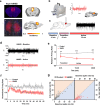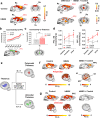Increased fMRI connectivity upon chemogenetic inhibition of the mouse prefrontal cortex
- PMID: 35217677
- PMCID: PMC8881459
- DOI: 10.1038/s41467-022-28591-3
Increased fMRI connectivity upon chemogenetic inhibition of the mouse prefrontal cortex
Abstract
While shaped and constrained by axonal connections, fMRI-based functional connectivity reorganizes in response to varying interareal input or pathological perturbations. However, the causal contribution of regional brain activity to whole-brain fMRI network organization remains unclear. Here we combine neural manipulations, resting-state fMRI and in vivo electrophysiology to probe how inactivation of a cortical node causally affects brain-wide fMRI coupling in the mouse. We find that chronic inhibition of the medial prefrontal cortex (PFC) via overexpression of a potassium channel increases fMRI connectivity between the inhibited area and its direct thalamo-cortical targets. Acute chemogenetic inhibition of the PFC produces analogous patterns of fMRI overconnectivity. Using in vivo electrophysiology, we find that chemogenetic inhibition of the PFC enhances low frequency (0.1-4 Hz) oscillatory power via suppression of neural firing not phase-locked to slow rhythms, resulting in increased slow and δ band coherence between areas that exhibit fMRI overconnectivity. These results provide causal evidence that cortical inactivation can counterintuitively increase fMRI connectivity via enhanced, less-localized slow oscillatory processes.
© 2022. The Author(s).
Conflict of interest statement
The authors declare no competing interests.
Figures






Similar articles
-
Concurrent tACS-fMRI Reveals Causal Influence of Power Synchronized Neural Activity on Resting State fMRI Connectivity.J Neurosci. 2017 May 3;37(18):4766-4777. doi: 10.1523/JNEUROSCI.1756-16.2017. Epub 2017 Apr 6. J Neurosci. 2017. PMID: 28385876 Free PMC article.
-
Functional-based parcellation of the mouse prefrontal cortex for network perturbation analysis.Cell Rep. 2025 May 27;44(5):115622. doi: 10.1016/j.celrep.2025.115622. Epub 2025 Apr 25. Cell Rep. 2025. PMID: 40287941
-
Aberrant intrinsic functional connectivity in thalamo-cortical networks in major depressive disorder.CNS Neurosci Ther. 2018 Nov;24(11):1063-1072. doi: 10.1111/cns.12831. Epub 2018 Feb 28. CNS Neurosci Ther. 2018. PMID: 29493113 Free PMC article.
-
Reduced sound-evoked and resting-state BOLD fMRI connectivity in tinnitus.Neuroimage Clin. 2018 Aug 31;20:637-649. doi: 10.1016/j.nicl.2018.08.029. eCollection 2018. Neuroimage Clin. 2018. PMID: 30202725 Free PMC article.
-
Levodopa reinstates connectivity from prefrontal to premotor cortex during externally paced movement in Parkinson's disease.Neuroimage. 2014 Apr 15;90:15-23. doi: 10.1016/j.neuroimage.2013.11.023. Epub 2013 Nov 22. Neuroimage. 2014. PMID: 24269570
Cited by
-
Analyzing asymmetry in brain hierarchies with a linear state-space model of resting-state fMRI data.Netw Neurosci. 2024 Oct 1;8(3):965-988. doi: 10.1162/netn_a_00381. eCollection 2024. Netw Neurosci. 2024. PMID: 39355437 Free PMC article.
-
Living on the edge: network neuroscience beyond nodes.Trends Cogn Sci. 2023 Nov;27(11):1068-1084. doi: 10.1016/j.tics.2023.08.009. Epub 2023 Sep 14. Trends Cogn Sci. 2023. PMID: 37716895 Free PMC article. Review.
-
Cortico-cortical transfer of socially derived information gates emotion recognition.Nat Neurosci. 2024 Jul;27(7):1318-1332. doi: 10.1038/s41593-024-01647-x. Epub 2024 May 20. Nat Neurosci. 2024. PMID: 38769153
-
Frontostriatal regulation of brain circuits contributes to flexible decision making.Neuropsychopharmacology. 2025 Jun;50(7):1156-1166. doi: 10.1038/s41386-025-02065-8. Epub 2025 Feb 14. Neuropsychopharmacology. 2025. PMID: 39953208 Free PMC article.
-
Glucose metabolism in hyper-connected regions predicts neurodegeneration and speed of conversion in Alzheimer's disease.Eur J Nucl Med Mol Imaging. 2025 Jun 5. doi: 10.1007/s00259-025-07379-9. Online ahead of print. Eur J Nucl Med Mol Imaging. 2025. PMID: 40471318
References
Publication types
MeSH terms
Grants and funding
LinkOut - more resources
Full Text Sources
Medical
Molecular Biology Databases
Miscellaneous

